What are Linking Verbs?
Linking verbs connect the subject of a sentence to more information about the subject. Rather than showing action, a linking verb links the subject to a subject complement (a word or phrase that provides additional information about the subject). These verbs help describe a state of being or condition.
Examples of Linking Verbs:
Some common linking verbs include:
- am, is, are, was, were (forms of “to be”)
- seem
- become
- feel
- appear
- look
These verbs do not show action but rather describe a state or quality of the subject.
Linking Verbs in Sentences:
| Sentence | Explanation |
|---|---|
| She is happy. | The verb “is” links the subject (She) to the complement (happy). |
| The food tastes delicious. | “Tastes” is a linking verb connecting “food” to “delicious.” |
| He seems tired. | The verb “seems” links “He” with the description “tired.” |
How to Identify a Linking Verb?
If the verb can be replaced with a form of “to be” and the sentence still makes sense, it is likely a linking verb. For example:
- The soup tastes good → The soup is good (the sentence remains logical).
What are Stative Verbs?
Stative verbs describe a state or condition rather than an action. They refer to thoughts, emotions, relationships, senses, possessions, and being. Unlike action verbs, which indicate something happening, stative verbs express something that exists or a quality that someone or something has.
Categories of Stative Verbs:
Stative verbs fall into several categories. Let’s break them down:
- Emotions: love, hate, like, dislike
- Thoughts: believe, know, understand, think (in a non-action sense)
- Possession: have, own, belong
- Senses: see, hear, smell, feel (when not an action)
- Being/Existence: be, exist
Stative Verbs in Sentences:
| Category | Sentence Example |
|---|---|
| Emotions | She loves ice cream. |
| Thoughts | I believe in hard work. |
| Possession | They own a beautiful house. |
| Senses | I smell roses in the garden. |
| Being/Existence | He is a doctor. |
Differences Between Linking Verbs and Stative Verbs
Though both linking and stative verbs can describe a state of being, they have distinct differences in how they function within sentences. Below is a comparison table to highlight the key distinctions:
| Aspect | Linking Verbs | Stative Verbs |
|---|---|---|
| Definition | Connect the subject to more information about the subject. | Describe a state, emotion, or condition. |
| Function | Link the subject to a subject complement. | Express a state of being or possession. |
| Usage Example | She is a teacher. | I own a car. |
| Replacement Test | Can often be replaced by a form of “to be.” | Cannot be replaced by “to be” without changing meaning. |
| Common Verbs | am, is, are, was, seem, look, appear | like, know, own, believe, see, love |
Advanced Understanding: Linking Verbs Can Also Be Stative Verbs
Some linking verbs can also function as stative verbs depending on the context. For example, the verb “feel” can be a linking verb or a stative verb.
- Linking Verb: The blanket feels soft.
(“feels” connects the subject “blanket” to the complement “soft.”) - Stative Verb: I feel tired.
(“Feel” describes the speaker’s state of being.)
In these cases, context helps determine how the verb is functioning.
Action Verbs vs. Stative Verbs: Understanding the Difference
It’s important to distinguish stative verbs from action verbs, as stative verbs do not usually take continuous forms (-ing). Let’s examine this in the table below:
| Verb Type | Sentence Example | Can it take a continuous form? |
|---|---|---|
| Action Verb | She is running fast. | Yes, action verbs take continuous forms. |
| Stative Verb | She knows the answer. | No, stative verbs generally do not use the continuous form. |
A sentence like “She knows the answer” would be grammatically incorrect because “know” is a stative verb and does not express an action.
Common Mistakes and Misunderstandings
- Using Stative Verbs in Continuous Forms: Many ESL learners make the mistake of using stative verbs in the present continuous tense. Remember that verbs like “love,” “believe,” and “own” do not take an -ing form.
- Incorrect: I am loving this book.
- Correct: I love this book.
- Confusing Linking Verbs with Action Verbs: Some linking verbs like “smell” or “feel” can also be action verbs, depending on the sentence.
- Action Verb: She is smelling the flowers (this indicates an action).
- Linking Verb: The flowers smell nice (this describes a state).
Linking Verb and Stative Verb with Examples
| Linking Verbs Examples | Stative Verbs Examples |
|---|---|
| She is smart. | I know the answer. |
| The cake looks delicious. | They own a house. |
| He seems tired. | She loves ice cream. |
| The flowers smell nice. | I believe in hard work. |
| The sky appears clear. | They prefer tea over coffee. |
| The soup tastes great. | He hates rainy days. |
| They are happy. | We understand the problem. |
| The movie was boring. | She likes this song. |
| It became cold quickly. | He dislikes loud music. |
| The room feels warm. | I see a bird outside. |
| His idea sounds interesting. | They have two cars. |
| She remains calm under pressure. | She wants a new phone. |
| This drink is refreshing. | He believes in honesty. |
| The painting looks beautiful. | She owns a collection of stamps. |
| The weather was perfect yesterday. | I feel tired today. |
| The new student seems friendly. | They know the rules. |
| The story sounds believable. | We need more time. |
| The water feels cold. | She loves reading books. |
| The dog looks excited. | I see the sunset every evening. |
| His explanation appears logical. | They have a big garden. |
Linking verbs and Stative verbs lists
- is
- looks
- seems
- smells
- appears
- tastes
- are
- was
- became
- feels
- sounds
- remains
- is
- looks
- was
- seems
- sounds
- feels
- looks
- appears
List of Stative Verb
- know
- own
- loves
- believe
- prefer
- hates
- understand
- likes
- dislikes
- see
- have
- wants
- believes
- owns
- feel
- know
- need
- loves
- see
- have
learn more helpful articles

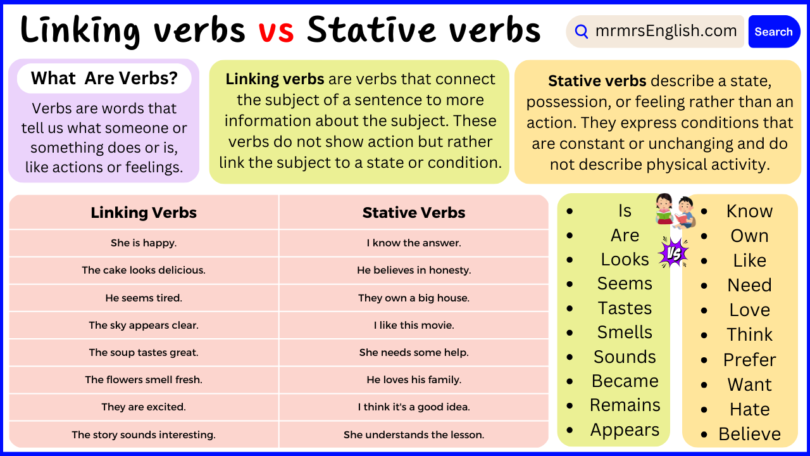




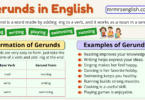
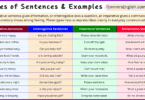
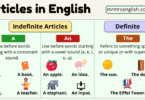
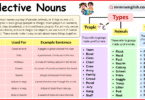

Leave a Comment